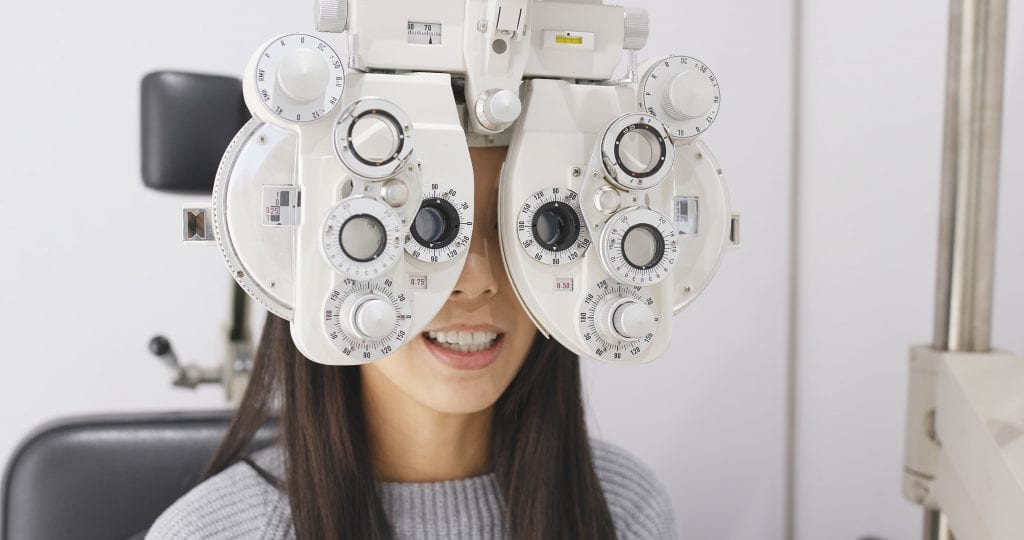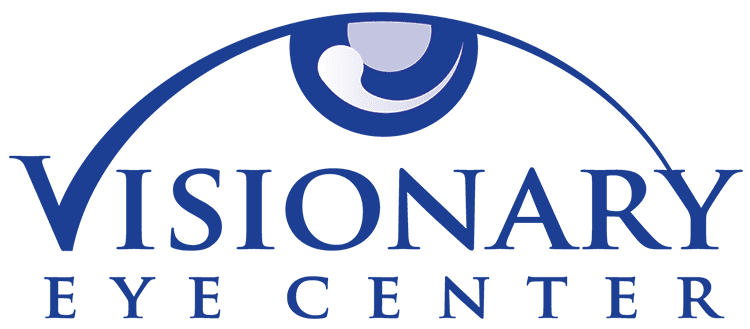SHOP DRY EYE CARE TODAY!
Use code VISIONARYEYE20 at checkout for 20% off!
As parents, we all wish to see our children thrive and excel in every aspect of their lives, and ensuring they have optimal vision is a crucial part of their overall development and well-being. At Visionary Eye Center in Reno, we understand the importance of early detection in preventing and treating pediatric vision problems. This guide is designed to help parents spot the early warning signs of vision issues in children, emphasizing the critical role of pediatric eye exams.
One of the first indicators that a child may be experiencing vision problems is a noticeable increase in squinting, blinking, or eye rubbing. These actions can be a child's instinctive response to try to clear their vision or relieve discomfort caused by eye strain. Frequent squinting might suggest your child is struggling to see clearly at a distance, indicative of myopia (nearsightedness), while difficulty focusing on close objects might point towards hyperopia (farsightedness) or astigmatism. Recognizing these behaviors as potential signs of vision issues is the first step towards seeking a pediatric eye exam.
Eye rubbing, especially if it's persistent, could also indicate eye fatigue or irritation. While it's normal for anyone to rub their eyes occasionally, constant rubbing might suggest an underlying issue that warrants a professional evaluation.

Children who experience discomfort when performing tasks that require near vision, such as reading or playing with small toys, may start to avoid these activities. This avoidance can be a subtle sign of vision problems. Parents might notice their child feeling frustrated or showing a lack of interest in learning activities they previously enjoyed. If your child is avoiding homework, reading, or engaging in detailed play, it could be a sign that these tasks are visually challenging for them due to uncorrected vision issues.
Another common sign that can indicate a vision problem is when a child consistently holds reading materials or digital devices too close to their face or sits nearer to the television than is typical. This behavior may suggest that your child is trying to compensate for blurred distance vision, a hallmark symptom of myopia. While many children like to sit close to the TV for fun, if your child seems to need to sit close to see clearly, it's time to schedule an eye exam.
Listen closely if your child frequently complains of headaches or eye pain, particularly after reading, doing homework, or spending time on a computer or tablet. These complaints can often be attributed to eye strain resulting from uncorrected vision problems. A comprehensive pediatric eye exam can help determine whether vision issues are the cause of your child's discomfort, providing a path to relief through proper vision correction.
If you've noticed any of these signs in your child, it's important to take action by scheduling a pediatric eye exam. Early detection and treatment are key to ensuring your child's vision development is on track. Visionary Eye Center in Reno is here to support your family with comprehensive pediatric eye care services. We encourage parents to observe their child's visual behavior and seek professional advice when concerns arise.
Regular pediatric eye exams are a vital part of children's health care routine, helping to catch and correct vision issues early. Contact us today to schedule an exam and take the first step towards safeguarding your child's vision.
Embarking on the journey of your child’s eye care can bring a mix of emotions, from curiosity to a bit of anxiety. Understanding what happens during a pediatric eye exam is crucial to demystifying the process and ensuring both you and your child approach this important health milestone with confidence. At Visionary Eye Center in Reno, we’re committed to providing a comforting and child-friendly environment for your family’s eye care needs. Here’s what you can expect during your child's first visit, helping to ease any apprehensions and make this experience a positive one.

Walking through the doors of Visionary Eye Center, you'll find a space designed with your child's comfort and curiosity in mind. The first pediatric eye exam is far from daunting; it's a non-invasive, engaging experience. Our eye care professionals are trained to work with children, explaining procedures in a way that’s easy to understand and ensuring that your child feels safe and valued throughout their visit. This initial appointment is not just about vision screening; it's an opportunity to build trust and lay the foundation for a lifetime of eye health.
From the moment you schedule your appointment, consider this an opportunity to talk to your child about the importance of seeing clearly and taking care of their eyes. Present the visit as a positive adventure, one where they'll get to play some "looking games" and maybe even look at some fascinating eye equipment, like the "pirate scope" or the "camera that takes pictures of your eye".
Preparation can make all the difference in ensuring a smooth and stress-free first eye exam for your child. Start by talking about the visit in positive, reassuring terms. Explain that the eye doctor is a friend who helps children see the world more clearly. You might even play pretend eye exams at home to familiarize your child with the concept.
Bring along a favorite toy or book as a comfort object. It's also helpful to write down any observations you’ve made about your child's vision or any concerns they’ve expressed, as well as questions you have, to discuss with the eye doctor.
A pediatric eye exam at Visionary Eye Center is thorough but straightforward. We start with vision testing using eye charts that may feature pictures or letters, catering to your child's age and reading ability. We assess eye alignment to ensure the eyes are working together properly and examine the health of the eye, from front to back, using lights and magnification. Techniques are gentle, and we strive to keep the atmosphere light and engaging, ensuring your child understands they can communicate any discomfort or ask questions at any time.
After the exam, we'll discuss the findings with you in clear, easy-to-understand language. Whether it’s prescribing glasses, recommending vision therapy, or simply scheduling the next check-up, we ensure you leave with a comprehensive understanding of your child's eye health and a plan for the future.
In the rare case that more specialized care is needed, we'll guide you through the options and next steps, ensuring you have the support and information needed to make the best decisions for your child's vision and overall well-being.
Your child’s first eye exam is more than a milestone—it’s the beginning of a lifelong journey towards maintaining healthy vision. By knowing what to expect and preparing your child for their visit, you're setting the stage for a positive and empowering experience. If you have any questions or wish to schedule your child's first pediatric eye exam, contact us at Visionary Eye Center in Reno. Together, we can ensure your child’s vision is clear and healthy, paving the way for a bright future.
In the bustling city of Reno, Nevada, a sanctuary of eye care exists that has been serving the community since 2004. Nestled among the landscapes of Sparks, Carson City, and Lake Tahoe, Visionary Eye Center is more than just an eye clinic; it is a haven for those seeking custom visual solutions crafted with the utmost expertise. Today, let's cast our gaze on the real visionaries behind this institution — Dr. Bolenbaker.
With a history spanning nearly two decades, Visionary Eye Center's unparalleled services can be attributed to the dedicated doctor who brings his wealth of knowledge to the examination room. His level of commitment isn't merely in treating eye conditions; it's about understanding the individuals who walk through the doors and providing tailored solutions to meet their specific needs.

There are countless eye clinics that offer glasses and contact lenses, but how many can boast a genuinely customized experience? At Visionary Eye Center, the idea of individualism extends far beyond selecting the color of your eyeglass frame. Here, Dr. Bolenbaker dedicates his time to offer solutions that are as unique as the eyes he treats. From custom size, shape, and color adjustments to a wide selection of custom lens options, the variety is incredible.
The center's contact lens clinic is nothing short of revolutionary. Led by a doctor who specialize in hard-to-fit conditions like keratoconus, you're not just another patient; you're a person in need of a specific solution. Custom color contact lenses and orthokeratology for myopia control? He has it all, and his expertise in this area is unmatched in the region.
Arguably, one of the most touching aspects of Visionary Eye Center is its low vision specialty clinic. Dr. Bolenbaker is not just a healthcare provider; he's a life-changer. He understand the struggles that partially sighted individuals face and have taken it upon themselves to offer a range of electronic aids and magnifiers to help these patients regain independence in their daily activities.
The scope of services offered at Visionary Eye Center is broad, to say the least:
Digital Lifestyle Exam: A thorough examination that adapts to modern-day digital needs.
Contact Lenses & Specialty Contacts: Ranging from standard options to highly specialized lenses.
Orthokeratology & Myopia Control: Leading-edge solutions for increasingly worsening childhood nearsightedness.
Low Vision Clinic: A unique specialty clinic for those with partial sight.
Medical Eye Care & Pediatric Eye Care in Reno: Providing comprehensive services for all age groups.
Dry Eye Care: Tailored solutions for one of the most common eye issues.
LASIK surgery: An option for those looking for a more permanent solution to their vision problems.
At Visionary Eye Center, technological advancements go hand in hand with a deep-rooted human touch. Amidst the spectrum of state-of-the-art services, the true distinction lies in the Dr. Bolenbaker's genuine approach to understanding patients. This is not a mere routine check-up; it's an exploration into the patient's lifestyle and individual needs. Visionary Eye Center propagates a holistic vision of eye care, embracing the belief that patient care resonates beyond clinical walls, reaching straight to the heart.
Peering into the horizon, Visionary Eye Center emerges as the beacon of advanced eye care in Northern Nevada and its surroundings. The establishment isn't just an eye care center; it's a testament to what the future of healthcare epitomizes. With a doctor dedicated to innovative techniques, empathetic patient interaction, and relentless commitment, the center exemplifies the pinnacle of healthcare.
March is National Save Your Vision Month, so what better time to schedule your annual eye exam. With Spring Break quickly approaching, it’s the perfect time for the whole family to see an optometrist in Reno. Dr. Bolenbaker and his team at the Visionary Eye Center look forward to meeting you and your family and taking care of your eye vision needs. As the best eye doctor in Reno, we offer pediatric eye care services to ensure that your child is developing proper depth perception, essential binocular skills and more.

Preventative eye care is important because eyesight is one of the most important senses. Eighty percent of what we perceive is because of our eyesight, so protecting your eyes will reduce the chance of blindness, vision loss, and long term eye diseases like cataracts and glaucoma. Vision disability is one of the top 10 disabilities among adults 18 years and older, and is one of the most prevalent disabling conditions among children. Because of our aging population, the CDC reports that the number of visually impaired individuals in the United States will double by 2030 and triple by 2050.
Other reasons to see an eye doctor in Reno include getting assistance with any decreased vision, eye pain, or double vision issues. We strongly encourage people to take care of their vision health, and the first step to it is making sure to schedule an annual eye exam. Visionary Eye Center can offer these important services in addition to exams:
Take care of your eyes and correct mild cases of farsightedness and presbyopia by beginning the safe processes of orthokeratology, myopia control, and more at our center today. The Lasik procedure is a great refractive practice to help with easily fixing any vision issues too.
Our Reno family eye care center is also one of the only low vision specialty clinics around, and there’s nothing more enriching than helping the partially sighted regain their independence.

We want the Reno community to be well informed on the best eye health decisions all year round. We offer several services for your eye health, whether it’s dry eye care, contact lenses, or myopia control. Don’t put off something as important as preventative eye care. The team at Visionary Eye Center are Reno optometrists with plenty of experience. Click here to schedule an appointment today. Please don’t hesitate to contact us with any general inquiries or concerns, and we look forward to meeting you!
Keratoconus may not be a familiar word for many people, but the disease affects a large number of eye care patients. Keratoconus (KCN) is a progressive eye disease that causes complications with the cornea. It results in vision problems that range from mild to severe and will likely require some form of corrective methods to improve the person’s ability to see.
Through years of research, professionals have been able to determine generally how many people have keratoconus, and the results are surprising. Since a 2017 study performed by Dr. Daniel Godefrooij, it was found that KCN affects roughly 5-10 times more patients than the original findings suggested. Let’s take a deeper dive into what keratoconus is below.

As stated above, keratoconus is a progressive eye disease that can impair a person’s vision and significantly affect the cornea. For patients with keratoconus, the cornea in one or both eyes becomes thin and scars in the center. Specifically, keratoconus involves the central portion of the cornea, which affects a large portion of the eye. The result is a noticeably protruding cornea that has an irregular conical shape followed by poor eyesight.
It’s typical for keratoconus to become present during puberty, or a person’s teen years, and worsens or progresses over time. By the 5th or 6th decade of life the disease will stabilize, but typically a patient with keratoconus will experience irregular astigmatism or scarring that might not be treatable by corrective lenses alone. In the worst cases, a patient may require a corrective procedure known as a corneal transplant.
Originally, research done in part by NKCF (National Keratoconus Foundation) suggested that 1 in 2,000 people were diagnosed with KCN. Years later in 2017, these numbers were questioned by Dr. Daniel Godefrooij who determined that these rates are significantly higher than what was traditionally found. When determining how many people have keratoconus, LASIK (laser in situ keratomileuses) eye surgery played a critical role.
LASIK is a popular method of vision correction that uses lasers to correct the refraction of eye lenses for patients suffering from myopia, hyperopia, and astigmatism. With the increased popularity of LASIK therapy came the realization that keratoconus affects more people than had been previously reported.
Today, Dr. Daniel Godefrooij reports the ratio of people suffering from KCN being 1 in 375. That’s more than 5 times as many people as researchers had originally found.
The cause of KCN is still mostly undetermined, but the development and progression of the disease have been heavily studied over time. Some research has suggested that chronic rubbing of the eyes may contribute to and possibly expedite the overall progression of the eye disease. The most common symptoms of keratoconus to be aware of include:
The plan of treatment for keratoconus will depend on the severity of the patient’s condition. Of utmost importance is early detection, as a recently FDA approved treatment called corneal cross-linking is now available to stabilize the condition. Mild KCN may be treated with the use of corrective lenses, such as eyeglasses or contact lenses. Moderate cases will likely require specialty contact lenses like gas permeable (GP), hybrids or scleral lenses to provide acceptable vision. However, severe forms of KCN may require more aggressive treatment methods such as a corneal transplant or Intacs Corneal Implants.
Keratoconus treatment focuses primarily on slowing the progression of the disease and improving vision. Essentially, there are three types of treatment to help with KCN symptoms which consist of corrective lenses, therapy, or surgery.
If you’ve been experiencing vision problems, it’s important to meet with your Reno optometrist to properly diagnose the issue at hand. You may be suffering from keratoconus and not even realize it. A licensed, trained optometrist can evaluate your vision problems, assess your eye health, and provide an effective method of treatment.
It may be necessary to consider eye surgery and specialty contact lenses to correct your vision problems caused by keratoconus. Dr. Bolenbaker at the Visionary Eye Center can help to develop a unique treatment plan that’s designed to suit your eye care needs.
It’s August, and that means it’s National Children’s Vision Month! Back-to-school season is also here, and there couldn’t be a better time than before your child returns to the classroom to take them to the eye doctor. One out of four school-age children suffer from some type of uncorrected vision problem, which can seriously impair their success in the classroom. Children are not always able to recognize by themselves that blurry vision or struggling to see near or far is actually a concern. And vision problems aren’t always issues with blurry vision, but rather eye alignment and focusing issues that lead to struggles in school, despite the fact they can see the classroom board clearly.
A routine school eye screening by an optometrist is necessary to detect vision problems and maintain overall optical health. You may have believed a school or pediatrician vision screening is enough. These are brief exams that evaluate visual acuity, the ability to read small letters or see a picture on a chart. These screenings are not comprehensive and can’t evaluate the way your child’s eyes work while reading or doing school work, nor can they adequately evaluate your child’s eye health. This means many vision problems aren’t detected, contributing to your child struggling in their academics or athletics.

According to the American Academy of Ophthalmology, it’s recommended that children receive an eye evaluation once before the age of 3, and at least every one to two years until the age of 19. Preschoolers should see a pediatric optometrist to ensure their eyes are aligned and focusing properly to address developing issues and halt progress down the road. During adolescence, a person’s eyesight can change rapidly and often, especially impacted by puberty, so they should continue to receive annual checkups. Of added importance, detecting myopia early is key as we now have FDA-approved technologies like the MiSight lens to slow the progression of near-sightedness or myopia. So we can now actually do something about your child’s prescription getting worse every year using myopia control techniques.
Scheduling an eye exam with your child’s optometrist before school begins will ensure they start the school year with the best overall vision to succeed! It eliminates the concern that vision or eye health could be interfering with your child achieving their highest academic potential. Proper eyesight can also prevent headaches, fatigue, and lack of focus in the classroom. You should also have your child’s lens prescription checked and kept up-to-date, especially if they are active in team sports or have a new classroom seat each year. Being proactive in ensuring your child regularly visits an optometrist is essential. After all, they own their eyes for life!
If you are a driver who also wears glasses, you’ve probably struggled to decide between which pair of glasses to put on in the car. Either way, you’re hindering your vision one way or the other. By not wearing your eyeglasses, you likely won’t be able to see near or far away depending on your eye condition. But not wearing sunglasses could mean being blinded by the harsh UV rays of the sun. The best option is to get yourself a pair of prescription sunglasses, that way you can achieve optimal vision.
When it comes to prescription sunglasses, there are many varying types to choose from. One of our favorites is the polarized sunglass lens that provides added protection to your eyes in harsh sunlight. Learn more about prescription sunglasses and polarized lenses below.
 The Importance of Protecting Your Eyes with Prescription Sunglasses
The Importance of Protecting Your Eyes with Prescription SunglassesMany patients are unaware of just how damaging UV rays can be on their eyes and do very little to protect them from mild or harsh sunlight. Even if there is cloud coverage in the sky, UV rays can still negatively affect your eyes. UV-A rays typically lead to problems with central vision and the macula which is part of the retina. UV-B rays are also damaging, mostly affecting the cornea and lens. Extended exposure to these harmful rays can lead to more serious eye conditions including:
Though many people are hesitant to spend the money on purchasing a second pair of glasses by buying prescription sunglasses, those who have are sure glad they did. Prescription sunglasses provide much-needed sight assistance even in high-light situations. When you’re driving down the street or taking your dog for a walk and the sun is glaring in your eyes, your regular prescription glasses will do very little to help you see. Likewise, wearing sunglasses with no prescription leaves you with very little vision. Prescription sunglasses, however, block out the sun while providing the same sight assistance as your glasses.
Prescription sunglasses can also help with light sensitivity, glare-related headaches, and regular eye strain from squinting in the sun. And if you’re worried about crow's feet, not squinting all the time from either harsh sunlight or blurry vision can help reduce those lines around your eyes.
First, it is important to note that not all sunglasses are polarized. While all sunglasses are designed to limit UV rays from penetrating through the lenses and limit glare, some are much more effective than others.
To understand how polarized sunglasses work, you need to know how light is reflected. Most sunlight that reaches our eyes is dispersed and scattered due to the fact that it often reflects off of uneven surfaces such as trees and roads. However, when sunlight is reflected from a smooth, shiny surface like the hood of a car, Lake Tahoe or a phone screen, the light is reflected in just one direction. The dispersed light is much less bothersome and damaging, while light that is directly reflecting into your eyes is more troublesome.
Polarized sunglasses are manufactured in a unique way that creates a different pattern within the lens that is able to block out more light than typical prescription sunglasses. A special film is laminated in between the lens surfaces in a vertical pattern. This helps block light and eliminate polarized glare entirely.

There are many advantages to wearing prescription sunglasses, especially with polarized lenses. Polarized lenses provide clearer vision in bright light, increases contrast, offer minimal color distortion, and reduces glare, reflection, and eye strain. And, the polarization is built directly into the lens, leaving a seamless finish for flawless vision. For anyone who spends time outdoors, polarized lenses will provide the best UV protection for your eyes.
When it comes to eye protection, eyeglasses and sunglasses are essential. With prescription sunglasses, you never have to worry about choosing which pair of glasses to put on again.
Visionary Eye Center is your home for custom vision solutions, and we take pride in offering top-tier care for each patient. We want our patients and community to be well informed to make the best health decisions for you and your family. Please don’t hesitate to contact us with any general inquiries or concerns, or schedule an appointment for an eye exam!
Just like with the rest of your body, age can have drastic effects on your eyesight. One of the most common age-related eye conditions out there is cataracts. You may be asking yourself, “what are cataracts?” and you’re not alone. Though many people have heard of cataracts, they’re less informed about the types, symptoms, and treatment of them. Considering how common cataracts are, it’s likely that you or a loved one may be affected by the eye condition if you don’t take the proper precautions. Take a look below to learn all you need to know about cataracts and see what you can do to protect yourself from developing this condition.
 What Are Cataracts?
What Are Cataracts?Cataracts are described as clouding of a normally clear eye lens. They affect the natural lens of your eye which leads to impaired vision and other sight complications. Typically, cataracts affect older patients over the age of 60 and are most noticeable in dim lighting. Fortunately, cataracts do form slowly and can be treated.
Though the cause of cataracts has not yet been fully determined, it’s understood that they form when proteins build up in the lens, making it appear cloudy. The cloudiness prevents light from passing through the lens clearly resulting in vision impairment. There may be several causes of cataracts, but generally, age, exposure to sunlight, and eye trauma are the biggest contributors.
The main symptom of cataracts is the inability to see clearly. Cataracts cause light to be blocked by the natural lens impairing your vision. Other signs and symptoms of cataracts include:
There are several types of cataracts including cortical, posterior subcapsular, and nuclear sclerotic cataracts.
Nuclear sclerotic cataracts are the most common and it’s very typical for people to develop them in their late age. This type of cataract forms in the center of the lens also called the nucleus. You may notice your vision improve for a brief amount of time when developing nuclear sclerotic cataracts but these effects do not last. Over time, your lens will begin to harden and become yellow or brown in color. It makes seeing small details almost impossible, dulls colors, and may result in seeing halos forming around objects.
Cortical cataracts are common in diabetes patients. These cataracts develop opposite from the nucleus, starting at the outer layer of the eye rather than the center. As it progresses, it creates noticeable spokes that lead from the outside in. A unique symptom of this type of cataract is experiencing changes in both contrast and depth perception.
Posterior Subcapsular cataracts develop much quicker than other types of cataracts, typically over months rather than years. Posterior cataracts start at the back of the lens and are most common in diabetes patients or those with extreme nearsightedness. Steroid use can also increase the risk of developing posterior subcapsular cataracts. With posterior subcapsular cataracts, you will first notice changes in your night vision and may also notice more difficulty reading.

The good news is that cataracts are easily treatable by medical and eye professionals. If you catch the condition early enough, a stronger prescription lens can improve your vision for some time. Typically, increasing your light source will also help vision in patients with cataracts, so be sure to add light to your home and use your new prescription glasses or contact lenses.
If these no longer work for you, then cataract surgery is going to be necessary. Cataract surgery is the only way to remove the cataract and fully treat it. There are several kinds of operations for cataracts, but they all require your surgeon to take out the cloudy lens and replace it with an artificial one. The surgery usually takes about 15 to 20 minutes, and you don't need to stay overnight in a hospital. If you have cataracts in both eyes, your doctor will wait until your first eye heals before they perform surgery on the second. More than 95% of people who have this done say they can see better afterward.
While there is no surefire way to prevent the onset of cataracts, there are some precautions you can take to limit your risk of developing cataracts. With risk factors such as increasing age and previous trauma or injury, there’s little you can do to keep eye problems from worsening. However, other risk factors can affect this as well. Some of them include:
In order to prevent cataracts from forming, try making some life changes such as:
Cataracts are the leading cause of blindness worldwide, though in the United States access to cataract surgery is readily available, so most Americans, fortunately, do not need to live with vision impairment from cataracts for very long. Should your condition require more advanced medical care, we work with many of the area's best specialty surgeons to co-manage any problems you may develop.
If you’re struggling with complications caused by cataracts or are just starting to develop cataracts, contact the Visionary Eye Center today! Here, we strive for customized eye care solutions for our Reno-Sparks patients and are eager to help you gain back control of your vision.
Vision problems can be a huge distraction in your daily life, making even casual tasks such as driving extremely difficult. One common vision problem that patients may experience is night blindness. You may be asking yourself, "what is night blindness?" and you're not alone. Someone with night blindness will have difficulty seeing in dark environments, which is especially noticeable when driving at night. Night blindness can be dangerous in some situations, so it’s critical that you get the help you need to alleviate your symptoms and get your eye health back on track.
For more information about night blindness, read the article below or contact our Reno optometrists today.
 What is night blindness?
What is night blindness?Night blindness, professionally known as nyctalopia, affects your ability to see at night or in poor lighting conditions. Although many people believe night blindness is an eye condition/disease all of its own, this actually isn’t true. Night blindness is the result of an underlying health issue such as cataracts, diabetes, or myopia. It’s also important to note that night blindness does not result in actual blindness but does lead to impaired vision in dark environments.
Night blindness often presents itself when transitioning from a well-lit area to a dark, poorly-lit environment. Our eyes naturally adjust and adapt to changes in light, but those with nyctalopia are typically unable to do this, resulting in poor visibility. If you have difficulty driving at night due to lousy vision or struggle to see in dark restaurants, movie theaters, etc., then you likely suffer from night blindness. However, many types of night blindness are treatable and symptoms often subside once the underlying issue has been resolved.
There are several possible causes of night blindness including:
 Symptoms:
Symptoms:The most common symptom of night blindness is experiencing poor vision in dimly lit or dark environments. However, this isn’t the only symptom that may present itself in those with nyctalopia. Other symptoms include:
Not all forms of night blindness can be treated, but a majority of them can be managed or remedied in some way. The treatment for your night blindness will vary depending on the cause of your condition. For example, if your night blindness is caused by myopia or nearsightedness, then new glasses or contact lens prescription may be recommended to alleviate your symptoms. And if your night blindness is caused by cataracts, surgery may be the only option for relief.
Other night blindness treatments may include a change in glaucoma medication or a visit with a retinal specialist. To determine your best course of action, it’s essential to visit your Reno eye doctor. They’ll be able to diagnose the cause of your night blindness and will provide the best treatment plan based specifically on your needs.
 See how you can prevent night blindness
See how you can prevent night blindnessAlthough some night blindness may be the result of a genetic disposition, other forms of nyctalopia may be prevented with some simple lifestyle changes. Try making these easy changes in your everyday life to help prevent the onset of night blindness:
Here, at the Visionary Eye Center, we strive for customized eye care solutions for all of our patients in the Reno-Sparks area. As each patients’ needs are unique, your treatment plan should be unique to you as well. We’ll work with you to determine the underlying cause of your night blindness to develop a solution that addresses your symptoms and treats your vision problems.
Our office uses the latest diagnostic technology and treatment solutions so you can receive cutting-edge options and not the bulk products that are found in other optometrists’ offices. Contact us today to get started with your personalized eye treatment. We look forward to meeting you!
Children and infants aren’t exempt from experiencing vision problems. Like adults, children can suffer from a variety of eye conditions including amblyopia, strabismus, and refractive errors such as nearsightedness and farsightedness. Genetic diseases such as glaucoma and cataracts may also affect children at a very young age. Thankfully, with regular vision checks, your child’s eyesight difficulties can be detected and treated early on. Start by learning the signs of vision problems in babies and children so you and your pediatrician can refer to an optometrist and rectify the situation before it gets out of control.

Eye exams should be done by your optometrist regularly. Unfortunately, pediatrician screenings aren’t designed to detect the subtle signs of early disease or vision problems. So, just like it is important to have your child see the dentist early, so too is it important to bring your child to an eye care professional at the following ages even if nothing seems wrong:
All children who wear glasses should have their vision checked yearly at their annual checkups. At these appointments, it will be determined how the vision problems are progressing and new glasses or contact lenses will be prescribed if necessary.

Vision problems may appear at any point in a child’s life. Many of the signs of vision problems in babies and children will be easy to spot, but some may go unnoticed if not closely monitored. If you notice any of the following signs or symptoms in your child, be sure to connect with your optometrist to see if further action should be taken:
Some vision problems may have no symptoms at all. Commonly, amblyopia (lazy eye) provides no obvious warning signs, which is why it’s so important to have your child’s eyes checked regularly. Tests can be done to determine if an eye condition is present or developing. Catching these signs early on is critical as it can help prevent your child from suffering chronic vision problems.
If you are concerned about your child’s eye health, or if you’re still wondering what are the warning signs of vision problems in babies and children, don’t hesitate to schedule them an appointment with an optometrist. Here at the Visionary Eye Center, we are equipped to offer pediatric eye care with the best options, treatment, and technology available.
We have developed techniques and technology specifically for children of all ages. When it comes to your child’s eye health, being proactive is essential. Feel free to contact us with any questions or concerns about your child’s vision, and don’t hesitate to schedule an appointment with us today! Visionary Eye Center is your home for custom vision solutions, and we take pride in offering top-tier care for each patient.
 775.827.1100info@visionaryeyecenter.com8175 South Virginia Street Suite B-900
775.827.1100info@visionaryeyecenter.com8175 South Virginia Street Suite B-900